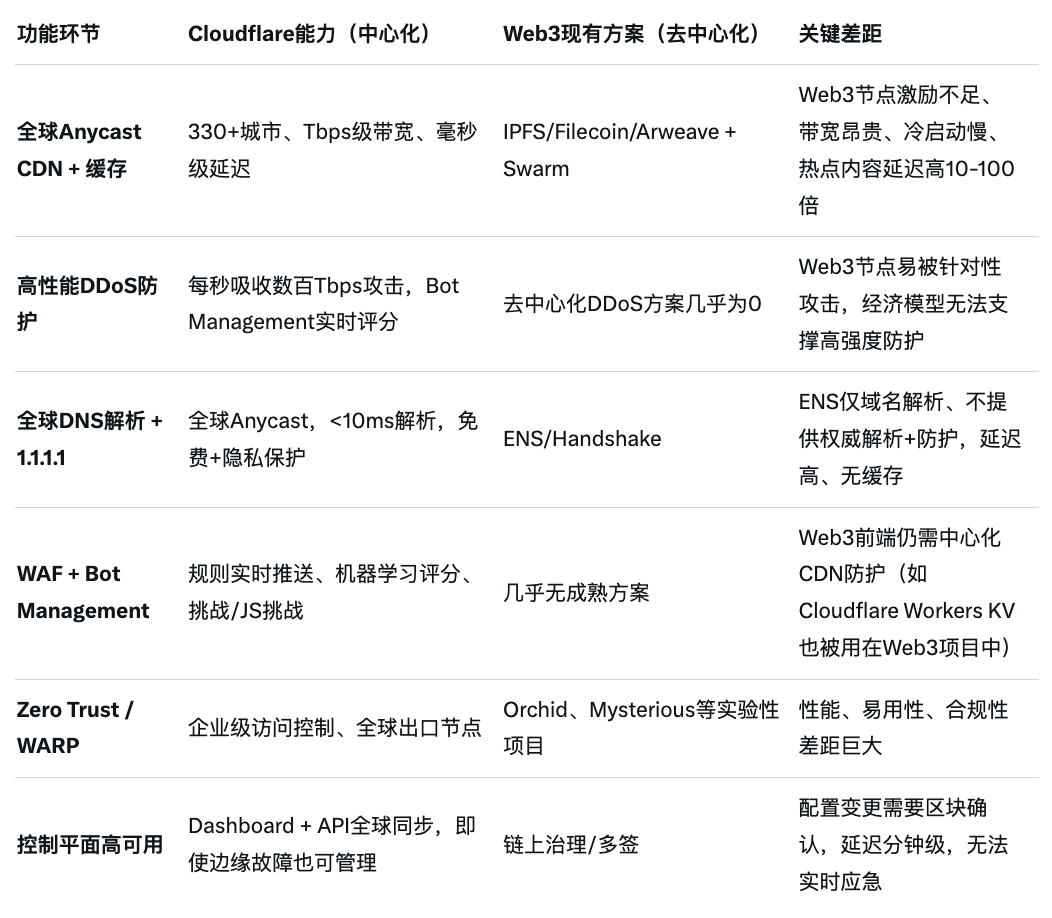Cloudflare outage shattered the decentralized filter of Web3.
Original article by Odaily Planet Daily ( @OdailyChina )
Author|Wenser ( @wenser2010 )
Last night, Cloudflare, the world's largest internet infrastructure service provider, experienced a downtime lasting several hours, causing numerous websites worldwide, including X and OpenAI, to crash, and several official websites of crypto projects were also affected.
Today, Cloudflare issued an official statement saying: "This large-scale outage was not caused by an external network attack, but by an incorrect configuration file generated after a database permission adjustment, which caused an anomaly in the core proxy system and triggered outages in multiple products, including CDN, security services, Workers KV, Turnstile, and Access. This is the most serious incident since 2019."
More importantly, this incident once again reveals a reality: even decentralized blockchain networks still struggle to break free from their dependence on centralized internet infrastructure . Odaily will provide a brief overview and analysis of this event below.
Cloudflare: The global internet "Jerusalem" has fallen, with 1/5 of the internet down.
Before discussing yesterday's outage, it's necessary to understand why Cloudflare is so important to the internet.
According to Cloudflare's official website, 20% of websites worldwide are protected by Cloudflare; it intercepts up to 234 billion cyber threats daily. Furthermore, the website shows that 30% of the Fortune Global 1000 companies rely on Cloudflare's services, including Twitter and OpenAI (mentioned earlier), as well as e-commerce platform Shopify, media group Thomson Reuters, media content company Canva, and Riot Games, the developer of the esports game League of Legends. Discord, a community product very familiar to crypto enthusiasts, is also a prime example of Cloudflare's customer base.


Furthermore, Cloudflare serves as the security frontline and content delivery network (CDN) for many independent and enterprise websites. A failure in Cloudflare is akin to a traffic accident on the global internet's highways, causing a complete gridlock and preventing internet users from bypassing it to connect to the website's main server. Even more absurdly, because official engineers initially mistook it for a DDoS attack, even Downdetector, a website that monitors real-time website status, became inaccessible for a time, creating the bizarre situation of "I'm down, but I can't detect that I'm down." This outage lasted for over 3 hours, with full recovery taking over 5 hours. Its wide-ranging impact and destructive power have led many to call it "the most serious internet infrastructure-level failure so far in 2025."
This morning, Cloudflare released an official outage analysis report stating that the large-scale outage on November 18th was not caused by an external network attack, but rather by an incorrect configuration file generated after a database permission adjustment. This caused an anomaly in the core proxy system, triggering interruptions in multiple products, including CDN, security services, Workers KV, Turnstile, and Access. This is the most serious incident since 2019. Initially, the team misjudged it as a DDoS attack, but ultimately fixed the problem by rolling back the old configuration file. All affected services were fully restored by 01:06 AM Beijing time on November 19th.
In response to this “internal mistake,” Cloudflare CTO Dane Knecht stated on X : “We have let down our customers and the wider internet; this was not an attack, but a problem that arose after we made routine configuration changes internally; any downtime is unacceptable, and we will do everything we can to win back that trust.”
It's worth noting that this isn't the first time Cloudflare has caused a "collective shutdown" of the internet, but it's the most severe one in nearly six years.
In 2013, a BGP routing misconfiguration caused Cloudflare's entire network to "disappear" from the internet, with all DNS and services down for about an hour;
In 2019, a catastrophic regular expression during a WAF hosting rule update triggered an exponential global CPU backtracking, causing half the internet to return 502/503 errors within 30 minutes. This was also Cloudflare's most serious internal problem-induced outage, according to Cloudflare.
In 2020, a CPU exhaustion bug during a routine code deployment was amplified, causing CPU usage on global edge nodes to spike to 100% and traffic to plummet by nearly 50% for about 30 minutes.
In 2022, during a backbone network configuration change, 19 high-traffic data centers were mistakenly taken offline simultaneously, causing more than 50% of websites worldwide to experience a traffic outage of nearly 1 hour and 40 minutes.
In 2023, a single core data center in Portland, USA, experienced a complete power outage (mains power + all generators failed), resulting in widespread unavailability of the Dashboard/API and analytics services.
In June of this year, a third-party storage infrastructure failure caused a global degradation of Workers KV, affecting multiple products including Workers, R2, and Zero Trust for 2 hours and 28 minutes.
The repeated outages and shutdowns inevitably lead us to consider a question that has long been avoided by the "Web3 narrative," "blockchain technology," and "decentralized networks": Can decentralized networks really replace centralized infrastructure like Cloudflare?
Cloudflare has no "Web3 version alternative": decentralized blockchain networks cannot function without centralized underlying services.
The answer is, of course, no.
In the past, whenever the internet experienced outages caused by centralized services, the crypto market was inundated with cries of "centralized services are unreliable" and "decentralized networks are the future." This July, on the tenth anniversary of Ethereum's stable operation, Vitalik Buterin even used Ethereum's "Ethereum has never crashed or stopped" as an example to highlight the unique advantages of decentralized networks. However, realistically, internet infrastructure like Cloudflare has virtually no "alternatives" among current Web3 infrastructures. The following is a comparative analysis compiled by Grok 4.1:

The harsher, more realistic truth is that the vast majority of Web3 projects rely on Cloudflare's services to run .
- The front-end is hosted on Vercel/Netlify (underlying Cloudflare).
- RPC nodes are protected with Cloudflare Gateway
- The official website, documentation, wallet links, and other website pages rely on Cloudflare.
It is no exaggeration to say that without Cloudflare, 90% of Web3 projects would be at a standstill.
The meme may be late, but it's here: Is a new Cloudflare employee being blamed? It's just a joke among netizens.
Another interesting thing about the Cloudflare outage was the recurring meme that emerged afterward—a user posted that they made some "minor updates" on their first day at Cloudflare, and netizens then embarked on their own meme-making journey, even creating a "Cloudflare Newcomer" meme.
- "On my first day at Cloudflare, my boss told me to go check out the server room and wished me good luck!"
- "My first day at Cloudflare was great, and I've already been promoted!"
Of course, this is just a meme; the netizen mentioned above previously posted a meme tweet about "joining Amazon Web Services." But from these memes, it's clear that netizens are no longer surprised by centralized infrastructure shutdowns, and faced with such situations, they have no choice but to make jokes and wait.
In conclusion, decentralized networks and centralized services are not an either-or choice, but rather a combined approach.
In conclusion, we must admit that centralized internet service solutions still far surpass centralized services in terms of performance, cost, security, and ease of use. The idea that decentralized infrastructure and blockchain networks can completely replace centralized services to handle the massive data and cloud service traffic of AI websites like X, Spotify, and OpenAI is nothing short of a pipe dream.
Cloudflare’s various outages have not been an opportunity for the large-scale adoption of decentralized networks, but they have made us reflect on the differences and unique advantages of Web3 decentralized infrastructure.
A few centralized giants still hold the reins of the internet, and we still have a long way to go before a truly decentralized network ecosystem. In the foreseeable future of the next 5-10 years, decentralized networks and centralized services will remain a combined approach, not an either-or choice.
However, the next time Cloudflare encounters problems, perhaps we can be less gloating over "centralized services are no good either," and more thoughtful about "when will we be able to truly not need to rely on it."
- 核心观点:去中心化网络仍依赖中心化基础设施。
- 关键要素:
- Cloudflare宕机致全球20%网站瘫痪。
- 内部配置错误引发核心系统异常。
- 90% Web3项目依赖其服务运行。
- 市场影响:暴露Web3对中心化服务的脆弱依赖。
- 时效性标注:长期影响



